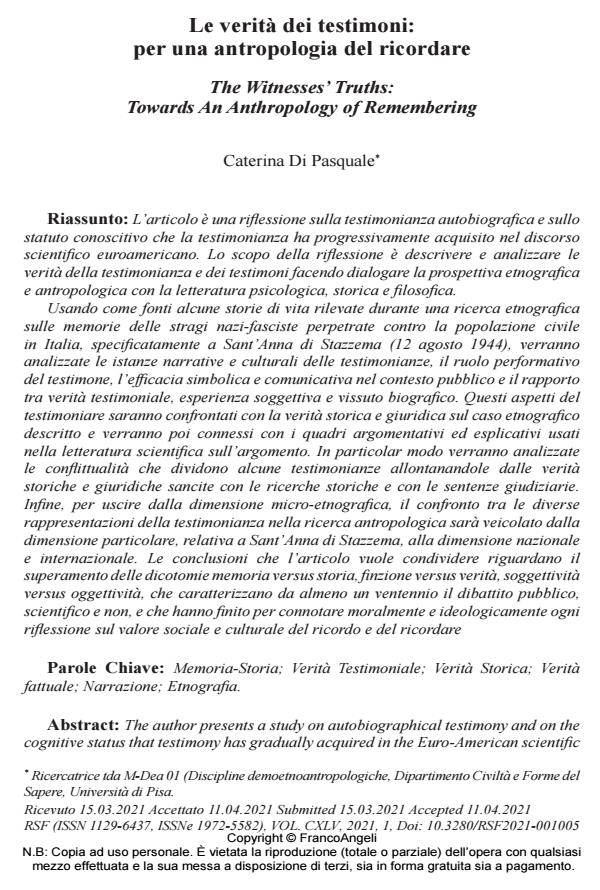The Witnesses’ Truths: Towards An Anthropology of Remembering
Journal title RIVISTA SPERIMENTALE DI FRENIATRIA
Author/s Caterina Di Pasquale
Publishing Year 2021 Issue 2021/1
Language Italian Pages 17 P. 87-103 File size 191 KB
DOI 10.3280/RSF2021-001005
DOI is like a bar code for intellectual property: to have more infomation
click here
Below, you can see the article first page
If you want to buy this article in PDF format, you can do it, following the instructions to buy download credits

FrancoAngeli is member of Publishers International Linking Association, Inc (PILA), a not-for-profit association which run the CrossRef service enabling links to and from online scholarly content.
The author presents a study on autobiographical testimony and on the cognitive status that testimony has gradually acquired in the Euro-American scientific discourse. This study describes and analyses testimonies’ and witnesses’ truths proposing a dialogue between an ethnographic and ‘anthropological perspective’ and a ‘psychological, historical and philosophical approach’. The author has chosen some life stories - discovered through an ethnographic research on the memories of the Nazi-Fascist massacres committed against the civilian population in Italy, precisely in SantʼAnna di Stazzema (12th of August 1944) - and studied the narratives and cultural instances of the testimonies, the performative role of the witnesses, the symbolic and communicative effectiveness in a public context and the relationship between witness to the truth, subjective experience and biographical experience. The author then compares some features of witnessing with the historical and legal truth of this ethnographic case presentation and connects them with other explanatory frameworks current in scientific literature. The author analyses in particular the conflicts, separating some testimonies, that move the testimonies away from the historical and juridical truths underlined by historical research and judicial sentences. Finally, to enlarge the micro-ethnographic study of Sant’Anna di Stazzema, the author analyses the testimonies’ different representations in national and international anthropological research. The author concludes underlining the setting aside of various dichotomies: memory versus history, fiction versus truth, subjectivity versus objectivity. Dichotomies that, for at least twenty years, have characterized the scientific and non-scientific public debate, and that are now morally and ideologically impacting all thoughts on the social and cultural value of memories and remembering.
Keywords: Memory-History; Testimonial Truth; Historical Truth; Factual truth; Storytelling; Ethnography.
Caterina Di Pasquale, Le verità dei testimoni: per una antropologia del ricordare in "RIVISTA SPERIMENTALE DI FRENIATRIA" 1/2021, pp 87-103, DOI: 10.3280/RSF2021-001005